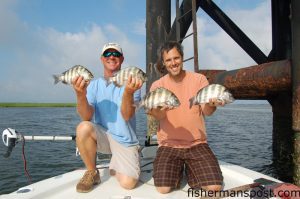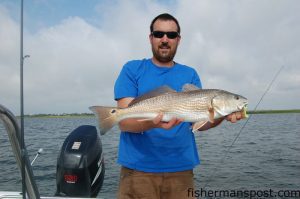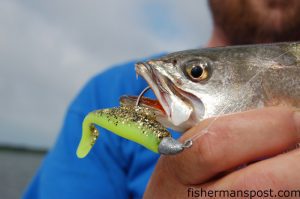Backwater Batting Order

Capt. Jeff Wolfe, of Seahawk Inshore Fishing Charters, and Gary Hurley, of Fisherman's Post with four sheepshead that couldn't resist live fiddler crabs dangled next to the legs of a range marker in the lower Cape Fear River.
Great baseball is all about great management, and after a recent trip with Capt. Jeff Wolfe, I’ve come to realize that adage applies equally aptly to fishing. While certainly controlling a team full of overpaid prima donna superstars would be a challenging exercise in frustration, I don’t think anyone would argue that keeping a squad of cantankerous fish in line and performing up to expectations also borders on the impossible.
Jeff, who runs Seahawk Inshore Fishing Charters out of Wilmington/Carolina Beach, had agreed to take Gary Hurley and me on an early morning sheepshead trip, something we’ve been trying to convince a captain to do for quite some time (without much success). Little did we know that Wednesday morning that the sheepies would simply be Jeff’s leadoff batters.
“I like a pretty slack tide for the sheepshead,” Jeff explained as we met him early morning at the Snow’s Cut boat ramp. “We’re going to head down the river and fish some structure near Southport on the low tide, then we might come back and hit the big bridge when it’s high around 11.”
With the game plan explained, Wolfe throttled up the 150 Suzuki powering his 21’ Kenner bay boat and we took off through the cut and into the river, gently buffeted by a light chop driven up by a southerly breeze blowing into the tail end of a Cape Fear falling tide. Flocks of ibis in Y and V formation that headed in the same direction barely gave us a second look, surely distracted by the thought of their first meal of the day.
The Kenner made quick work of the trip, and shortly after breezing past the yellow cranes of Sunny Point and the Pfizer dock, Jeff had us tying the Kenner alongside one of the range-markers that help guide ships up the river. A pair of ospreys nesting atop the marker were substantially less indifferent to our presence than the ibis had been, wheeling and shrieking to make clear their displeasure at the intrusion on their domestic bliss.
“Just tie us off up there,” Jeff said, motioning at a pipe paralleling the water’s surface. With bow and stern made fast to the marker, he produced a bucket brimming with fiddler and mud crabs he’d collected the evening before and gave us a brief hooking lesson.
“You want to drop it down beside the pilings,” Jeff explained, making creative use of some old jackets to protect the Kenner’s hull from the barnacled and rusted piling supporting the marker. “If you don’t feel anything for a minute or so, lift up a foot or two and let it hang there. Just wind if you feel one bite.”
We attempted to follow his advice for a moment while Jeff baited another rod, and soon the three of us were spread along the boat’s port gunwale, all intent on the piling in front of us and the almost telepathic act of feeling a sheepshead bite.
I believe it was Gary’s second drop when I heard a commotion at the back of the boat and saw the medium-action spinner Jeff had handed Gary doubled over and a grin on the boss’s face. Jeff was quick to reach for a net, but the battle was over quickly and Gary saved him the trouble, swinging a sheepshead a bit larger than a hand over the rail. It wasn’t a monster by any means, but we were on base, and with the target sheepie in the boat just moments after we’d tied the boat up, our game plan was looking solid.
Despite the fish’s size, it had put up a valiant—if brief—struggle, and I (almost certainly along with Gary) was surprised to see the sheepshead wasn’t larger.
Jeff was quick to follow with a slightly larger fish, though still one that could easily be flipped over the Kenner’s rail, and after a quick photo of each, our little sheepies went on their merry way.
Apparently my telepathic skills were lagging behind those of my boatmates, as I went through a solid half-dozen crabs, reeling up either a bare hook or a smashed and empty shell. Finally my rod bowed up on what felt like a substantial fish, but it materialized into a near-triplet of the two we’d already boated.
I was relieved to see Jeff and Gary losing crabs at nearly the same rate I was, however, with a ratio of at least 5 or 6 crabs sent down before a fish hit the deck. Still, it was rare for any of us to drop a crab more than twice without a bite, and at that rate we started putting fish in the boat at least every five minutes, with the occasional double hookup when two of us had the simultaneous skill (or fortune) to, as sheepshead gurus wax frequently, “set the hook just before they bite.”
At this rate, we began to put a few keepers in the 1-2 lb. class in the boat, continuing, as well, to lose baits at a rate unequalled by any type of fishing I’ve ever done previously. Fortunately, Jeff is rather familiar with this drill and had brought several hundred of each type of crab.
“I guess this is a bit like baseball,” Gary exclaimed after losing another fiddler. “If you can maintain a .300 average, you’re doing great.”
I’m not sure any of us were putting up those hall-of-fame numbers, but we boxed up another four keepers, moving around to explore the other side of the marker with similar results before Jeff revealed the contingency plan he had on deck.

The author with a 26" red drum that inhaled a Strike King Redfish Magic paddletail near a shelly point in the marsh near Bald Head Island.
“It’s like this sometimes,” he explained after swinging another beautifully striped, but diminutive fish in the boat. “Sometimes they’re all fairly nice 2-4 lb. fish with some bigger ones thrown in, and sometimes they’re all the ones we’re catching today. Our tide’s starting to move, and the bite’s slowing down a little bit. You guys want to go catch a redfish?”
Jeff made his own answer to the question clear when he picked up a rod rigged with a topwater plug and fired a long cast at a nearby grass bank.
“Do we have to?” Gary replied with a smirk. “Of course we do!”
This brought a smile to the captain’s face as well, and he fired up the Suzuki before casting off the ropes that had held our bow and stern tight to the marker.
After a very brief run out into the river and through a twisting channel into a tidal creek behind Bald Head Island, Jeff scrambled to the bow and dropped his trolling motor into the water.
Surrounded by marsh grass, divided by cedar hammocks and with both the Old Baldy and Caswell Beach lighthouses looking over us, there’s no way I could’ve imagined a more idyllic setting for our redfish hunt to begin.
“We’re going to work up one side of this bar,” he explained, motioning to a sand and oyster spit in the midst of the creek while handing Gary and I each a rod rigged with a light jighead. “I’m going to throw a topwater, and you guys toss some soft plastics.”
Opening an overstuffed pocket in the side of his tackle bag to reveal a serious collection of soft baits, Jeff tossed us each a Redfish Magic paddletail grub in a pair of colors that each featured some heavy chartreuse trim.
“If it ain’t chartreuse, it ain’t got no use,” he said with a chuckle.
“These baits are tough,” he continued, demonstrating by stretching one of the plastics to at least twice its length and letting it snap back into form. “The little bluefish and pinfish have a lot harder time taking the tails off than with a normal grub.”
We commenced casting, bumping our grubs along the bottom while Jeff walked a Spook, Jr. topwater along the edge of the drop-off that the bar created.
The utility of the Redfish Magic grubs was proven on my very first cast, as something small and unseen voraciously nipped at the bait, but was unable to tear it up. Unfortunately, that was all the action we had along the bar, and Jeff didn’t put up with that for long.
“We’re going to bump around that corner,” he said, firing up the Suzuki but proving it would be a short move by leaving his trolling motor down for the brief jaunt.
As the ripples receded from our short move, Jeff switched over to his own jighead/soft plastic combo, and he motioned to an area where the creek bank took a slight dip between two shelly points while guiding us towards it with the trolling motor.
“We’re going to pick up a fish right over there,” he proclaimed confidently.
Sure enough, it was Gary whose rod tip snapped up as soon as we got in casting range of Jeff’s spot and had taken only about five turns on the reel handle.
“What is it, Gary?” Jeff excitedly queried while I tried to send a cast into the same area without interfering with the boss’s fish. “Looks like a flounder.”
Indeed, the fish hadn’t taken off with the bulldogging runs of a red or the head-shaking initial burst of a speckled trout, the two most likely other candidates in that spot, Jeff explained. Instead, the fish stayed down in the water, bouncing Gary’s rod with a spastic cadence once in a while, but otherwise playing nice at first.

Capt. Jeff Wolfe and Gary Hurley, with a pair of 2-3 lb. flounder (part of a fast quartet) that fell for Redfish Magic paddle tail grubs along a shell bed in a creek near Bald Head Island.
It wasn’t until Gary had played the fish close enough for us to make a positive ID that the fat, 2-3 lb. flattie decided to put up a little resistance. As I reached out with Jeff’s landing net for the fish, it apparently didn’t like what it saw, finding the energy for a dash deep and towards one of the shell points. The next time Gary pressured the mottled flatfish to the surface, the net was waiting and the flounder hit the deck.
It wasn’t a redfish, but I don’t know anyone who doesn’t enjoy catching (or eating) a flattie, and with the healthy flounder in the boat, we combined a quick photo session with a round of celebratory exultations.
Eager to continue casting, we aborted the celebration quickly, tossed the flounder in the cooler, and got back to it. Hurley’s number was almost immediately called again, and a squealing drag next gave me occasion to look his way.
The doubled rod made it clear he’d hooked something more substantial, and shortly, a healthy red drum boiled 20 yards off the bow, swiftly changing directions and forcing Gary to step off the casting deck to follow suit. Torn between making a cast to the area where he’d now hooked up twice or grabbing the camera to try and nail a few action shots of the battle, I finally set my rod in one of the console holders, picked up the Nikon, and began snapping away.
As the species is wont to do, the drum put up an excellent account of itself in battle, leading Gary on a lap around the boat and keeping him busy by alternating short bursts of drag-peeling speed with dogged sideways resistance when Gary tried to use the light-action spinning rod to pressure him to the boat.
Eventually, the fish relented to Gary’s coaxing, perhaps with the knowledge that it would be released, and Jeff was able to slide a net under the well-fed 25 incher. Fortunately for the bronzed battler, we already had some fish in the boat, and after it posed for a few snapshots, Jeff quickly revived it and sent it on its way.
Eager at this point to hook a fish of my own, be it a red, flounder, trout, or virtually anything else, I didn’t have to wait long. A cast or two later and in the same general area where Jeff had had so much confidence, something smashed my jig and took off along the marsh bank, the spinner’s drag squealing as the fish tore through the shallows.
With a broad grin spreading across my face, I followed the red as it swung wide around the bow, getting away from the marshline into open water where it turned on the juice, taking the drag’s song up another octave.
Ultimately, the resistance took its toll, and I was able to gain back a bit more line before the fish’s next bullish attempt at freedom.
After a few more moments where the outcome of the give-and-take battle was in doubt, I began to feel I had the upper hand, and 30 seconds later Jeff slid the net under the feisty red. This one was an inch longer than Gary’s but had more bulk as well, and an identical twin would’ve put a team high on the leader board at a redfish tournament.
Just like our first red, this one got a gentle revive-and-release treatment after a few photographs, and we were soon back to casting.
Another cast a few moments later led to another bite, and this time a spunky speckled trout broke the surface with a wild headshake. Though spirited, the redfish-appropriate drag quickly took its toll, and Jeff was quickly sliding the net under the final component of an inshore slam—a grand slam counting the sheepshead.
As we celebrated, it dawned on Gary and I that this was the first inshore slam we’d ever had on a Guide Time trip—a sheepshead trip at that.
“We should give Jeff a t-shirt or something,” I said excitedly, realizing that not only did we have the slam, we’d done it all on artificials around 20 minutes after we started casting.
“No, dude, we throw him in the water,” Gary replied. “That’s how it’s done.”
We refrained, but our excitement was unabated as Jeff continued guiding us along the marsh grass with the trolling motor.
“Now that you guys have a slam, you’ve got to let me catch one,” Jeff said as we rounded another marsh point. His words weren’t out of his mouth for more than a minute before he reared back on what became another upper-slot red.
With the boat slam accomplished, I was now intent on catching a personal one, a feat I’ve never accomplished with three legal fish (there’s always a spike trout in there), and I began chanting an internal flounder mantra in the hope that today would be my day.
Somehow, I was unable to make the flounder happen. However, I was more than content to settle for another pair of beautiful upper-slot reds and a fat whiting that hit like it was turbocharged, confusing me when I saw its uniquely dark-striped back materialize out of the dark river water.
Gary and Jeff got some ammo to rub it in a bit by going on a flounder tear, pulling four (none smaller than 2 lbs.) off another shell bar dividing one of the creeks we’d worked our way into while I frantically casted into the areas they’d just pulled fish off of only to see them hook another one where I’d just been casting.

This speckled trout found a Strike King Redfish Magic paddletail grub irresistible along a broken shell bank in a marsh creek behind Bald Head Island.
While we continued fishing our way through the labyrinth of creeks that meander behind Bald Head, a rather nasty-looking thunderstorm cropped up, pounding Carolina Beach and Wilmington with rain, but treating us to nothing more than a riveting light and sound show as we fished under a sunny sky.
Sighting a break in the weather, we took the opportunity to head back to the ramp where some afternoon obligations awaited both Jeff and Gary. Amazingly, despite the dark clouds still blanketing the area, the storm seemed to have run its course and we never felt the first drop of rain.
With sheepshead leading off, Capt. Jeff Wolfe filled out the rest of the lineup card with flounder, red drum, and speckled trout to complete what can only be called a grand slam.
To find out how you can book a trip with Jeff or get more information about Seahawk Inshore Fishing Charters, give him a call at (910) 619-9580 or visit www.seahawkinshorefishingcharters.com.
